Abstract
The aim is to evaluate the ease of access, surgical trauma and cosmetic results of posterior sagittal approach for sacrococygeal teratomas (SCTs). From January 2002 to June 2010, we operated 19 cases of SCT exclusively through posterior sagittal approach. Patients were placed in knee chest position. An elliptical incision was made for the excision of the tumor. Care was taken to preserve all the muscles and other vital tissue in this area. Coccygectomy was performed in all patients. Closure was performed in layers. It was possible to resect all tumors from this approach and none of the patients required revision of the incision. Complete resection was possible in 17 patients while two had residual disease due to local extension. Minimal wound dehiscence was noted in four patients that healed spontaneously. It was possible to perform excision even in very large masses. Wound scar was satisfactory in most patients with preservation of gluteal folds. It is therefore concluded that posterior sagittal approach for SCT is feasible, with good access and cosmetic results.




Similar content being viewed by others
References
Derikx JP, De Backer A, van de Schoot L, Aronson DC et al (2007) Long-term functional sequelae of sacrococcygeal teratoma: a national study in The Netherlands. J Pediatr Surg 42:1122–1126
Chirdan LB, Uba AF, Pam SD, Edino ST, Mandong BM, Chirdan OO (2009) Sacrococcygeal teratoma: clinical characteristics and long-term outcome in Nigerian children. Ann Afr Med 8:105–109
Pini Prato A, Martucciello G, Torre M, Jasonni V (2004) Feasibility of perineal sagittal approaches in patients without anorectal malformations. Pediatr Surg Int 20:762–767
Fishman StevenJ, Jennings RussellW et al (2004) Contouring buttock reconstruction after sacrococcygeal teratoma resection. J Pediatr Surg 39(3):439–441
Celayir AC, Sander S, Eliçevik M, Unal M (2002) Posterior sagittal approach for treatment of presacral masses in infancy. Pediatr Surg Int 18:208–210
Draper H, Chitayat D, Ein SH, Langer JC (2009) Long-term functional results following resection of neonatal sacrococcygeal teratoma. Pediatr Surg Int 25:243–246
Author information
Authors and Affiliations
Corresponding author
Rights and permissions
About this article
Cite this article
Jan, I.A., Khan, E.A., Yasmeen, N. et al. Posterior sagittal approach for resection of sacrococcygeal teratomas. Pediatr Surg Int 27, 545–548 (2011). https://doi.org/10.1007/s00383-011-2870-z
Accepted:
Published:
Issue Date:
DOI: https://doi.org/10.1007/s00383-011-2870-z




